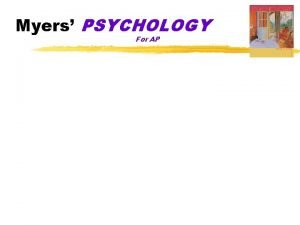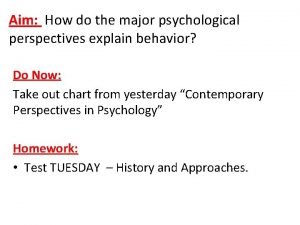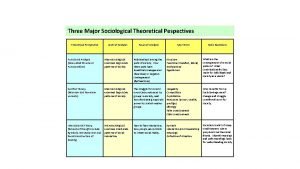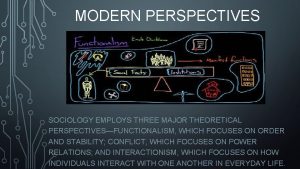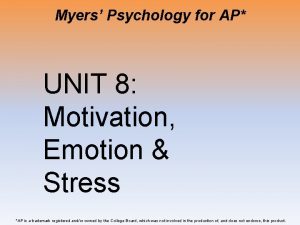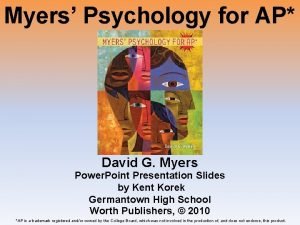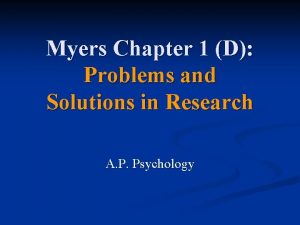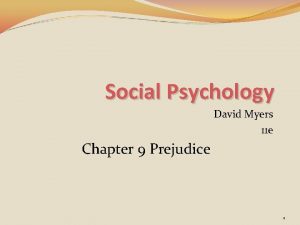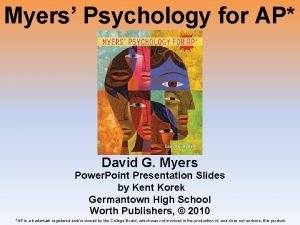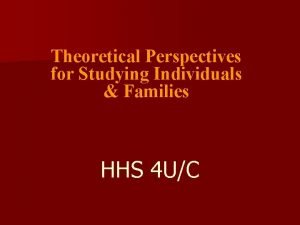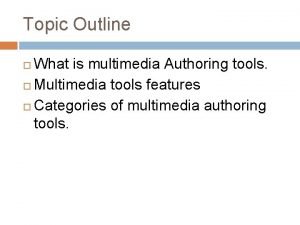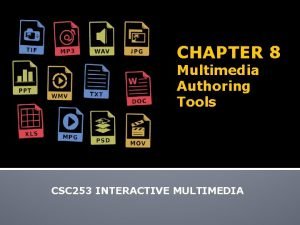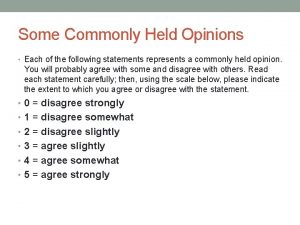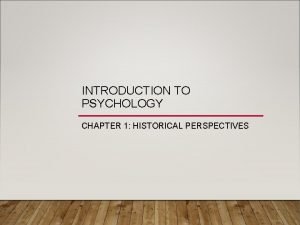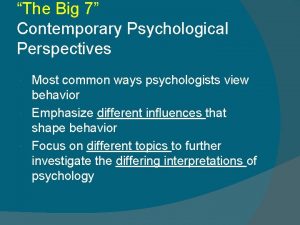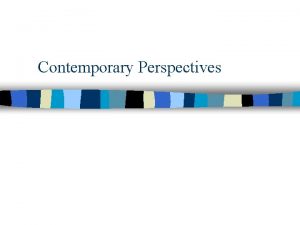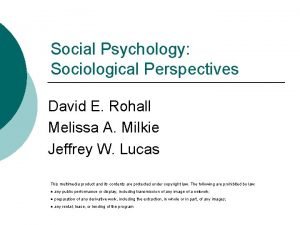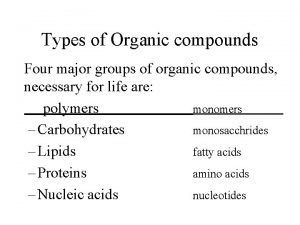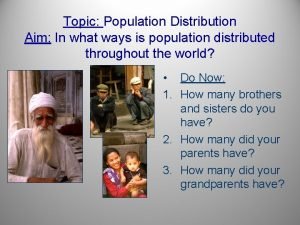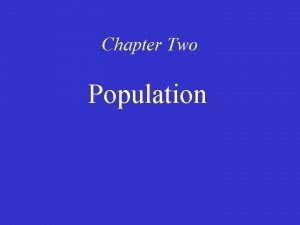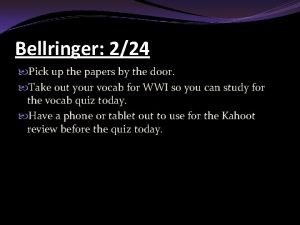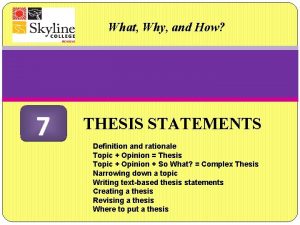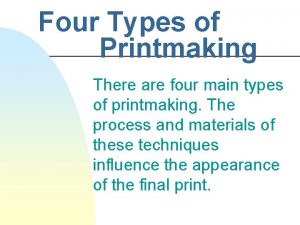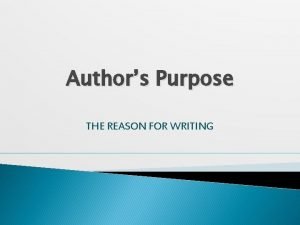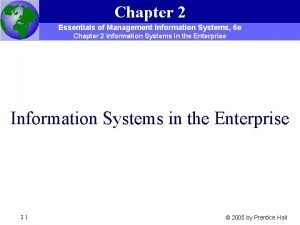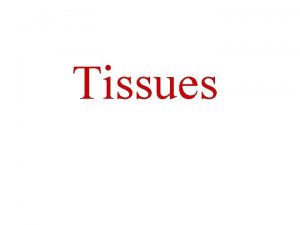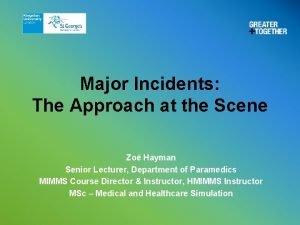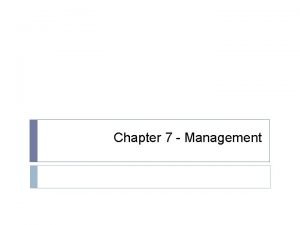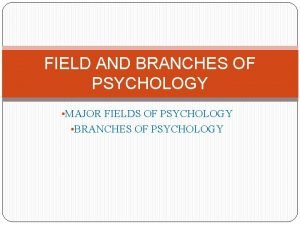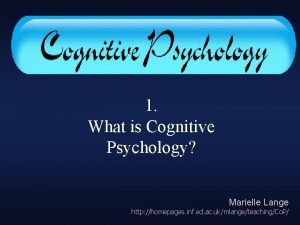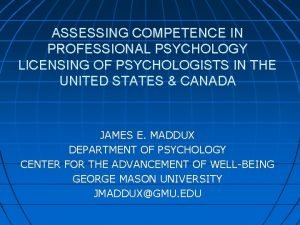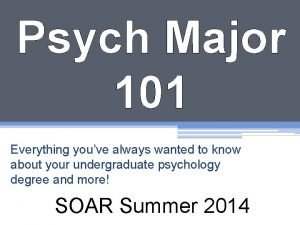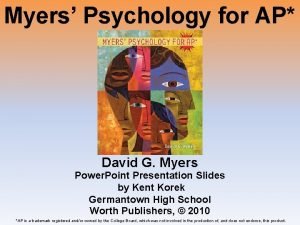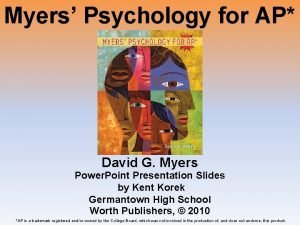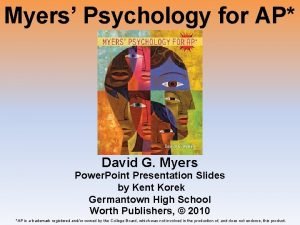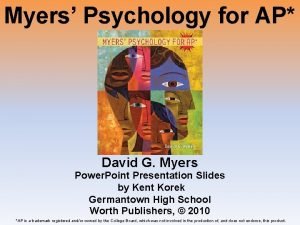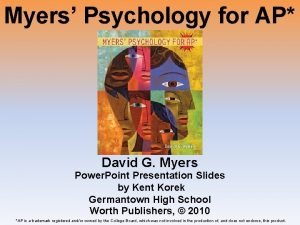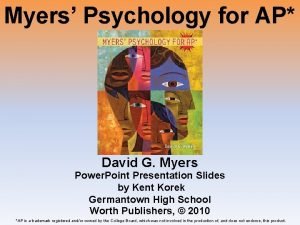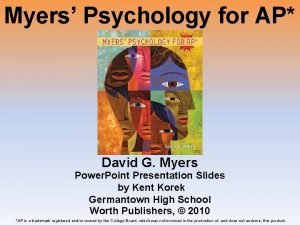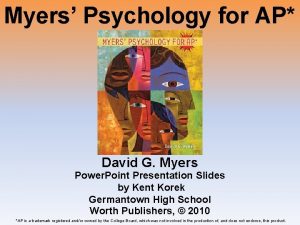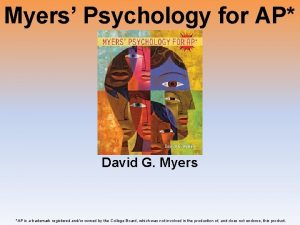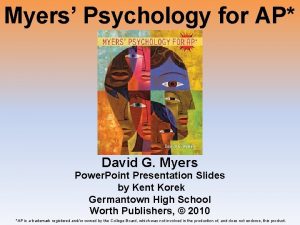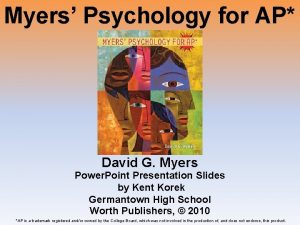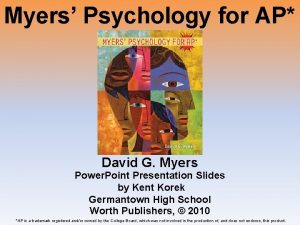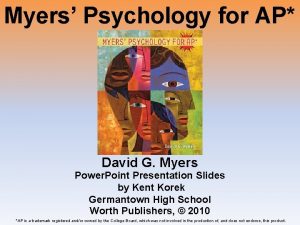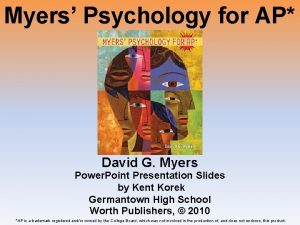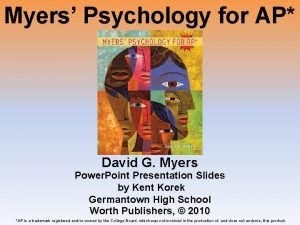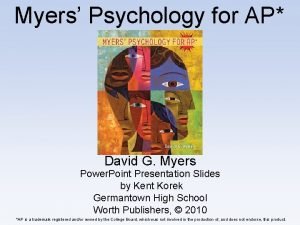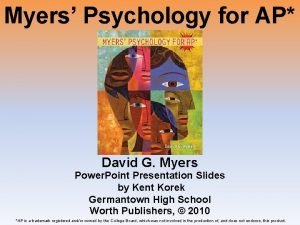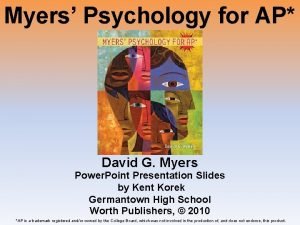Myers PSYCHOLOGY For AP Four Major Perspectives on
































































- Slides: 64

Myers’ PSYCHOLOGY For AP

Four Major Perspectives on Personality z 1. Psychoanalytic Theory(Freud) z 2. The Trait Perspective (Myer-Briggs and Big Five Factors) z 3. The Humanistic Perspective (Maslow and Carl Rogers) z 4. The Social Cognitive Perspective (Albert Bandura)

What is Personality? § Personality § an individual’s characteristic pattern of thinking, feeling, and acting § basic perspectives § Psychoanalytic § Humanistic z Personality theories do not seek to make value judgments on peoples behavior. Describe how people behave and categorize them to seek understanding.

What do these words mean to you? z. Fixated? z. Repressed? z. Regressed? z. Anal-retentive? z. Oedipus complex? z. Rationalize?

Answers…. All thanks to Freud! z Fixated - to be stuck on a particular object or way of behaving. z Repressed – to have suppressed thoughts, feelings or memories too painful to bear. z Regressed – to act in an immature way. z Anal-retentive – to be obsessively neat and organized. z Oedipus complex – a condition in which a boy loves his mother and hates his father. z Rationalize – to explain away a problem or justify one’s own behavior.

The Psychoanalytic Perspective § From Freud’s theory which proposes that childhood sexuality and unconscious motivations influence personality

The Psychoanalytic Perspective § Psychoanalysis § Freud’s theory of personality that attributes our thoughts and actions to unconscious motives and conflicts § techniques used in treating psychological disorders by seeking to expose and interpret unconscious tensions

The Psychoanalytic Perspective § Free Association § in psychoanalysis, a method of exploring the unconscious § person relaxes and says whatever comes to mind, no matter how trivial or embarrassing

The Psychoanalytic Perspective § Unconscious § according to Freud, a reservoir of mostly unacceptable thoughts, wishes, feelings and memories § contemporary viewpoint- information processing of which we are unaware

Personality Structure § Id § contains a reservoir of unconscious psychic energy § strives to satisfy basic sexual and aggressive drives § operates on the pleasure principle, demanding immediate gratification § An innate part of personality that is selfish, pleasure driven, and demands

Personality Structure § Superego § the part of personality that presents internalized ideals § provides standards for judgement (the conscience) and for future aspirations § A part of the personality structure that cautions people to do the right thing

Personality Structure § Ego § the largely conscious, “executive” part of personality § mediates among the demands of the id, superego, and reality § operates on the reality principle, satisfying the id’s desires in ways that will realistically bring pleasure rather than pain

Personality Structure Ego Conscious mind Unconscious mind Superego Id § Freud’s idea of the mind’s structure § Freud believed that people were like icebergs – only a small bit of our personalities are shown, and we keep the rest hidden from others. § Like an iceberg, most of ones personality is below the surface. .

Doh! The relationship between the ID, EGO and SUPEREGO…. Each gives the person advice and one has to choose who to listen to. The devil represents the ID that encourages more licentious behavior. The angel represents the SUPEREGO, the part that advises the obedience to moral and ethical principles. Homer represents the EGO, which must take both types of advice and make the most realistic decision.

Do you show your TRUE Self? z. Do you feel others around you know “the real you”? z. What types of things do people keep hidden from casual friends and acquaintances? Why? z. What types of things do the share?

Common Issues/Questions in Personality Theories z Free will or determinism…Are we free to choose –to be masters in our fate-or are we victims of biological factors, unconscious forces or external stimuli? z Nature vs nurture…is our personality determined primarily by the predispositions we inherit, or are we shaped by our environment? z Past, present or future…Is personality development basically complete in early childhood? Or is personality capable of being influenced by present experiences and by future aspirations and goals? z Uniqueness or universality…Is the personality of each individual unique or are there brad personality patterns that fit large numbers of persons?

Common Issues/Questions Con’t z. Equilibrium or growth…Are we primarily tension-reducing, pleasure seeking animals or are we motivated primarily by the need to grow? z. Optimism or pessimism…Are human beings basically good or evil?

Personality Development § Psychosexual Stages § the childhood stages of development during which the id’s pleasure-seeking energies focus on distinct erogenous zones § Oedipus Complex § a boy’s sexual desires toward his mother and feelings of jealousy and hatred for the rival father § Hans fear of horses…was a displaced fear of his father…he also had castration anxiety…from his parents telling him that they would cut off his penis if he continued to play with it. His sister didn’t have a penis so he concluded that it must have been cut off.

Penis Envy

Freud and the ID… z. Freud though that people were born with an active ID, but developed the EGO and SUPER EGO though experiences in childhood. Because infants are such needy creatures, Freud saw their behavior as evidence of the innate ID, calling infants a “seething cauldron” of desires.

Personality Development Freud’s Psychosexual Stages Stage Focus Oral (0 -18 months) Pleasure centers on the mouth-sucking, biting, chewing Anal (18 -36 months) Pleasure focuses on bowel and bladder elimination; coping with demands for control Pleasure zone is the genitals; coping with incestuous sexual feelings Phallic (3 -6 years) Latency (6 to puberty) Dormant sexual feelings Genital (puberty on) Maturation of sexual interests

Personality Development § Identification § the process by which children incorporate their parents’ values into their developing superegos § Fixation § a lingering focus of pleasure-seeking energies at an earlier psychosexual stage, where conflicts were unresolved

Fixations (Oral and Anal Stages) z If a person was weaned too early, then he or she would show signs of oral fixation later in life, always putting objects in their mouth, chain smoking, or overeating. z In the anal stage, fixation occurs in one of two ways. If potty training occurs too early, a person can become anal retentive – overly neat and fussy about details and organization. z If potty training is not encouraged or allowed to happen haphazardly, a person can become anal – explusive overly slovenly or messy.

Defense Mechanisms § the ego’s protective methods of reducing anxiety by unconsciously distorting reality (devices used to protect people from the pressures of the world. ) § Repression § the basic defense mechanism that banishes anxiety-arousing thoughts, feelings, and memories from consciousness

Defense Mechanisms § Regression § defense mechanism in which an individual faced with anxiety retreats to a more infantile psychosexual stage, where some psychic energy remains fixated

Defense Mechanisms § Reaction Formation § defense mechanism by which the ego unconsciously switches unacceptable impulses into their opposites § people may express feelings that are the opposite of their anxiety-arousing unconscious feelings

Defense Mechanisms § Projection § defense mechanism by which people disguise their own threatening impulses by attributing them to others § Rationalization § defense mechanism that offers selfjustifying explanations in place of the real, more threatening, unconscious reasons for one’s actions

Defense Mechanisms § Displacement § defense mechanism that shifts sexual or aggressive impulses toward a more acceptable or less threatening object or person § as when redirecting anger toward a safer outlet

Freud and Falsifiability z. Much of Freud’s theory fails the test of falsifiability- his theory does not allow for it to be false. When people would challenge Freud’s interpretations of their experiences, he would say they were being “resistant”. The theory proved itself making it difficult to test hypotheses in scientifically valid ways.

Assessing the Unconscious § Projective Test § a personality test, such as the Rorschach or TAT, that provides ambiguous stimuli designed to trigger projection of one’s inner dynamics § Link to Freud’s defense mechanism projection…clients would attribute their negative feelings to someone or something else, making it safer to those types of feelings. § Projective tests enable people to apply their feelings to a picture, which the analyst interprets to explain hidden feelings and experiences.

Assessing Continued § Thematic Apperception Test (TAT) § a projective test in which people express their inner feelings and interests through the stories they make up about ambiguous scenes

Assessing the Unconscious--TAT

Assessing the Unconscious § Rorschach Inkblot Test § the most widely used projective test § a set of 10 inkblots designed by Hermann Rorschach § seeks to identify people’s inner feelings by analyzing their interpretations of the blots

Assessing the Unconscious--Rorschach

Neo-Freudians § Alfred Adler § importance of childhood social tension. Important to feel worthwhile to overcome inferiority. § Karen Horney § sought to balance Freud’s masculine biases § Carl Jung § emphasized the collective unconscious § concept of a shared, inherited reservoir of memory traces from our species’ history. Archetypes

Alfred Adler & Social Tension Connection z Adler’s view of social tensions shares a relationship to Erikson’s theory of Psychosocial development. In order for growth, one must struggle and interact in a social setting. z Adler coined the term, inferiority complex…this occurs when we underestimate our own capabilities…opposing tendency = superiority complex.

Karen Horney z Fully developed the idea of neurosis, or a driving need for something or someone. z Se believed neuroses helped to make life bearable, giving us a sense of something to strive for. z Only when people didn’t fulfill a need or became obsessed with a particular need did these neuroses become problematic and interfere with life. z She identified 10 neurotic needs that can be classified into 3 main categories: x Compliance – needs of affection, a partner, and to simplify one’s life. x Aggression – including needs for power, exploitation of others, prestige, personal admiration and personal achievement. x Withdrawal – including needs for independence and perfection.

Carl Jung z Theory of collective unconsciousness includes his descriptions of archetypes. Archetypes can include: y Hero (Savior or Deliverer) y The Quest (undertaking a long journey or a battle to accomplish a lofty purpose) y The Scapegoat (when a hero must die to sacrifice something to save others) y The Great or Good Mother (represents warmth, fertility and abundance) y The Terrible Mother or Witch (represents danger, fear and death) y The Soul Mate or Princess (respresens inspiration and fulfillment)

Friday Class

Humanistic Perspective § Abraham Maslow (19081970) § studied selfactualization processes of productive and healthy people (e. g. , Lincoln)

The Third Force: Humanistic Psychology z. Prior to the 60’s, there were two dominant groups of psychologists: Behaviorists and Psychoanalysts…then came the Humanists = a breath of fresh air for examining human behavior.

Humanistic Perspective § Self-Actualization § the ultimate psychological need that arises after basic physical and psychological needs are met and selfesteem is achieved § the motivation to fulfill one’s potential

Humanistic Perspective § Carl Rogers (1902 -1987) § focused on growth and fulfillment of individuals § genuineness § acceptance § empathy § to facilitate his 3 aspects he would answer questions with questions. § Supportive and they would self cure.

Criticizing Rogers z. Roger’s idea about humanistic psychology do favor an individualistic perspective on the self. z. Criticism = many of his ideas need to have cross culture studies. Only then can we determine if these phenomena are universal and are influenced by culture.

Humanistic Perspective § Unconditional Positive Regard § an attitude of total acceptance toward another person § Self-Concept § all our thoughts and feelings about ourselves, in an answer to the question, “Who am I? ”

Contemporary Research-The Trait Perspective § Trait § a characteristic pattern of behavior § a disposition to feel and act, as assessed by self-report inventories and peer reports § Personality Inventory § a questionnaire (often with true-false or agree -disagree items) on which people respond to items designed to gauge a wide range of feelings and behaviors § used to assess selected personality traits

The Trait Perspective Moody Anxious Rigid Sober Pessimistic Reserved Unsociable Quiet UNSTABLE Hans and Sybil Eysenck use two primary personality factors as axes for describing personality variation Factor Analysis Research Method EXTRAVERTED§ The Greeks identified 4 types sanguine Sociable of fluids that give rise to Outgoing personality types: Touchy § Restless Aggressive Excitable Changeable Impulsive Optimistic § Active melancholic choleric INTROVERTED phlegmatic Passive Careful Thoughtful Peaceful Controlled Reliable Even-tempered Calm Talkative Responsive Easygoing Lively Carefree Leadership STABLE § (excesses = personality) § § Blood =sanguine Black Bile = melancholic Green Bile = choleric Yellow Bile = phlegmatic

The Trait Perspective § Minnesota Multiphasic Personality Inventory (MMPI) § the most widely researched and clinically used of all personality tests § originally developed to identify emotional disorders (still considered its most appropriate use) § now used for many other screening purposes

The Trait Perspective § Empirically Derived Test § a test developed by testing a pool of items and then selecting those that discriminate between groups § such as the MMPI

The Trait Perspective Clinically significant range Hypochondriasis 1 (concern with body symptoms) Depression 2 (pessimism, hopelessness) After treatment (no scores in the clinically significant range) Hysteria 3 (uses symptoms to solve problems) Psychopathic deviancy 4 (disregard for social standards) Before treatment (anxious, depressed, and displaying deviant behaviors) Masculinity/femininity 5 (interests like those of other sex) Paranoia 6 (delusions, suspiciousness) Psychasthenia 7 (anxious, guilt feelings) Schizophrenia 8 (withdrawn, bizarre thoughts) Hypomania 9 (overactive, excited, impulsive) Social introversion 10 (shy, inhibited) 0 30 40 50 60 T-score 70 80 § Minnesota Multiphasic Personality Inventory (MMPI) test profile

The Trait Perspective The “Big Five” Personality Factors Trait Dimension Description Emotional Stability Calm versus anxious Secure versus insecure Self-satisfied versus self-pitying Extraversion Sociable versus retiring Fun-loving versus sober Affectionate versus reserved Openness Imaginative versus practical Preference for variety versus preference for routine Independent versus conforming Extraversion Soft-hearted versus ruthless Trusting versus suspicious Helpful versus uncooperative Organized versus disorganized Careful versus careless Disciplined versus impulsive Conscientiousness

Trait vs Social Cognitive Theories z. Central debate = how we attribute or explain peoples behavior(s). z Trait theorists focus on dispositions – inborn qualities that are relatively consistent over a lifetime. z Social Cognitive theorists emphasize the power of the situation s on human behavior, which change from moment to moment.

Social-Cognitive Perspective § views behavior as influenced by the interaction between persons and their social context § Reciprocal Determinism § the interacting influences between personality and environmental factors

Reciprocal Determinism Explanation z ABC = A=Affect or thoughts and emotions B=Behaviors C=Consequences Helpful hints – know your definitions… Reciprocal = 2 or more parties exchanging something ie. Information. In this theory, thoughts, environment and behaviors are interacting exchanging information about how and why we behave. Determinism = refers to the inevitable consequences of actions. Consequences are determined by actions that precede them. In this theory, our actions are determined by the interactions of our environment and or thoughts.

Social-Cognitive Perspective

Social-Cognitive Perspective § Personal Control § our sense of controlling our environments rather than feeling helpless § External Locus of Control § the perception that chance or outside forces beyond one’s personal control determine one’s fate

Social-Cognitive Perspective § Internal Locus of Control § the perception that one controls one’s own fate § Learned Helplessness § the hopelessness and passive resignation an animal or human learns when unable to avoid repeated aversive events (Seligman’s research)

Social-Cognitive Perspective § Learned Helplessness Uncontrollable bad events Perceived lack of control Generalized helpless behavior

Social-Cognitive Perspective § Positive Psychology § the scientific study of optimal human functioning § aims to discover and promote conditions that enable individuals and communities to thrive § There are positive health effects for those who are optimistic. § Being overly optimistic can lead to poor decisions and risks. § BALANCE!

George Kelly’s Personal Construct Theory z He argued that we use bipolar personal constructs to interpret and predict events. z For example, we might use cold-hot, flexibledogmatic, intelligent vs. unintelligent, tall-short to create an image of a new acquaintance. z Using these constructs a person might conclude that a strange is warm, flexible intelligent and tall. z One might use further constructs to determine if he is academically intelligent or street smart.

Exploring the Self § Spotlight Effect § overestimating others noticing and evaluating our appearance, performance, and blunders § Link to adolescent egocentrism – teens often think that everyone is thinking of them. . their looks, behavior etc…. difficult for them to look “outside” of themselves. § Self Esteem § one’s feelings of high or low self-worth § Self-Serving Bias § readiness to perceive oneself favorably

Exploring the Self § Individualism § giving priority to one’s own goals over group goals and defining one’s identity in terms of personal attributes rather than group identifications § Collectivism § giving priority to the goals of one’s group (often one’s extended family or work group) and defining one’s identity accordingly

Exploring the Self Value Contrasts Between Individualism and Collectivism Concept Individualism Collectivism Self Independent (identity from individual traits) Interdependent identity from belonging) Life task Discover and express one’s uniqueness Me--personal achievement and fullfillment; rights and liberties Maintain connections, fit in What matters We-group goals and solidarity; social responsibilities and relationships Coping method Change reality Accommodate to reality Morality Defined by individuals (self-based) Defined by social networks (duty-based) Relationships Many, often temporary or casual; confrontation acceptable Few, close and enduring; harmony valued Attributing behaviors Behavior reflects one’s personality and attitudes Behavior reflects social and roles

The Modern Unconscious Mind § Terror-Management Theory § Faith in one’s worldview and the pursuit of self-esteem provide protection against a deeply rooted fear of death
 Four major perspectives of psychology
Four major perspectives of psychology The outrageous celebrity psychology
The outrageous celebrity psychology 7 major perspectives in psychology
7 major perspectives in psychology Major perspectives in psychology
Major perspectives in psychology Two sociological theoretical perspective? *
Two sociological theoretical perspective? * Three major theoretical perspectives in sociology
Three major theoretical perspectives in sociology Psychology ninth edition in modules
Psychology ninth edition in modules Myers ap psych unit 8 vocab
Myers ap psych unit 8 vocab Psychology eighth edition david g myers
Psychology eighth edition david g myers Myers psychology for ap
Myers psychology for ap David g myers psychology 8th edition
David g myers psychology 8th edition Psychology ninth edition david g myers
Psychology ninth edition david g myers Myers' psychology for ap solutions
Myers' psychology for ap solutions Psychology tenth edition in modules
Psychology tenth edition in modules Social psychology by david myers
Social psychology by david myers Psychology in everyday life myers
Psychology in everyday life myers Myers' psychology for ap
Myers' psychology for ap Four theoretical perspectives
Four theoretical perspectives Four perspectives of curriculum
Four perspectives of curriculum Icon based authoring tools example
Icon based authoring tools example Released now multimedia authoring system
Released now multimedia authoring system Andrea yates psychology worksheet
Andrea yates psychology worksheet 7 perspectives of psychology
7 perspectives of psychology Contemporary psychology definition
Contemporary psychology definition Psychology perspectives
Psychology perspectives Historical perspectives of psychology
Historical perspectives of psychology 7 perspectives of psychology
7 perspectives of psychology Contemporary perspectives
Contemporary perspectives Social psychology sociological perspectives
Social psychology sociological perspectives Four types
Four types Four major population clusters
Four major population clusters Cartogram world population
Cartogram world population Convergent plate boundaries
Convergent plate boundaries Body tissues chapter 3 cells and tissues
Body tissues chapter 3 cells and tissues Who were the four major allied countries?
Who were the four major allied countries? Buffalo and toronto differ in four major ways
Buffalo and toronto differ in four major ways Major historical perspective of nursing and computer
Major historical perspective of nursing and computer Four basic categories of printmaking
Four basic categories of printmaking A computer system consists of both hardware and software
A computer system consists of both hardware and software Types of author's purpose
Types of author's purpose Four major rivers in virginia
Four major rivers in virginia The four major enterprise applications are
The four major enterprise applications are 4 major tissues
4 major tissues Four major biomolecules
Four major biomolecules Four stages of a major incident
Four stages of a major incident 7 management functions
7 management functions Industrial organizational psychology ucf
Industrial organizational psychology ucf Branches of industrial psychology
Branches of industrial psychology 5 major domains of psychology
5 major domains of psychology 5 major domains of psychology
5 major domains of psychology Csulb psychology major requirements
Csulb psychology major requirements Towson university phd programs
Towson university phd programs Major schools of thought in psychology
Major schools of thought in psychology Fspos
Fspos Typiska novell drag
Typiska novell drag Tack för att ni lyssnade bild
Tack för att ni lyssnade bild Vad står k.r.å.k.a.n för
Vad står k.r.å.k.a.n för Shingelfrisyren
Shingelfrisyren En lathund för arbete med kontinuitetshantering
En lathund för arbete med kontinuitetshantering Särskild löneskatt för pensionskostnader
Särskild löneskatt för pensionskostnader Tidböcker
Tidböcker Sura för anatom
Sura för anatom Förklara densitet för barn
Förklara densitet för barn Datorkunskap för nybörjare
Datorkunskap för nybörjare Boverket ka
Boverket ka
